If you happen to interact with a bunch of 9-13-year-olds, you will be thrilled by the observational tendencies the children in this age group possess. In addition to being exceptionally observant, they raise questions like ‘why’ and ‘how’ about everything that they see. They seem to be in pursuit of learning something new every day.
This is because the development of human brain occurs to its maximum during the first few years of life. This is the time the person learns the new concepts the quickest. This can be demonstrated by the example of linguistics. Children and adults, if exposed to a new language, the children possess the greater capability for an early grasp on the speaking and listening of the new language as compared to the adults. Some say that child’s brain is like a sponge soaking every bit of information you expose it to.
Why Are Schools the Perfect Places to Raise Awareness?
The very definition of a school makes it fair to say that they have a responsibility towards creating better future for our coming generations. We send our children to schools every day not only to learn how to spell, count, read, write but also for the exposure of the current affairs such as environmental awareness through a school fundraiser.
How to Define Environmental Awareness?
Although self-explanatory, this term can be defined as being aware of your surroundings that is the environment. When we say environment, we refer to all flora and fauna, encompassing the marine and wildlife as well. The environmental challenges faced by the planet Earth are massive. They include:
- Pollution
- Climate change
- Water shortage
- Global Warming
- Droughts
- Floods
- Deforestation
Giving our children the necessary awareness about these issues that result in a change in our lifestyles is what this campaign is about. Using trees for education.
Practical Tips for Raising Awareness
Starting the conversation remains vital to any awareness campaign. It can be fruitful to make environmental awareness part of school’s curriculum. The echo-school initiative is another step in this regard:
- This initiative fundamentally encourages the young people to protect their environment by engaging in healthy practices.
- This initiative has augmented thousands of schools to be environmentally aware in 62 countries.
Here are some tips to put this plan into action:
- 3 R’s: Reduce, Reuse and Recycle can be a wholesome approach towards teaching the children about global warming.
- Arrange school fundraiser that involves planting trees with the informational banners that tell why trees are crucial for the environment.
- Teach the children about cutting down on their energy use by switching off all the electrical machines when not in use.
- To combat the water scarcity, ask them to turn-off the taps properly to avoid unnecessary water wastage.
Actions Speak Louder than Words
It is human nature to focus on actions rather than the words. While teaching about the environmental impacts of our day-to-day activities is important, it can be a lot more fruitful if we, as adults, lead by example. The teacher can plant trees themselves as some pair of little might always be watching you.
It is Important to Spread the Word
The last step of this awareness campaign includes sharing the word. Practicing at home is a good idea because it would bear no result if children adopt these practices at schools but let the taps drip at their home.

